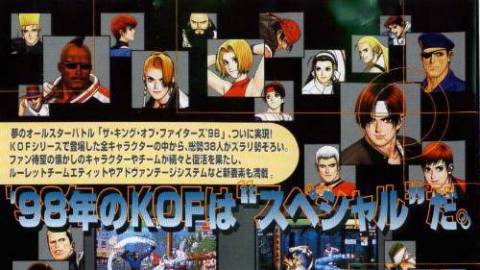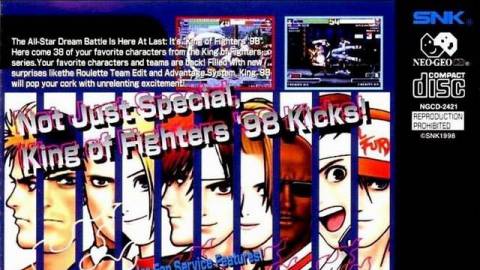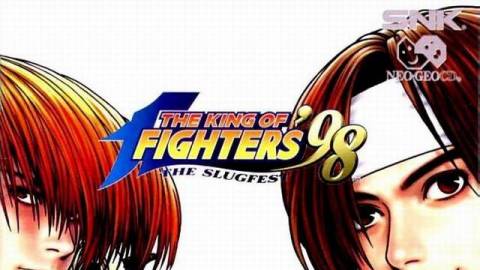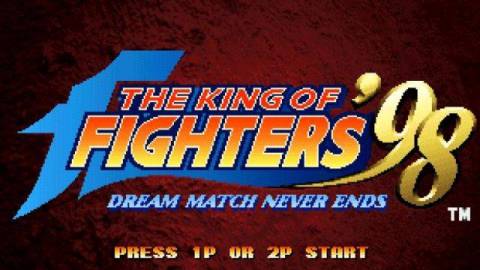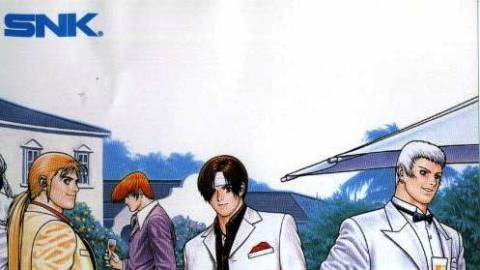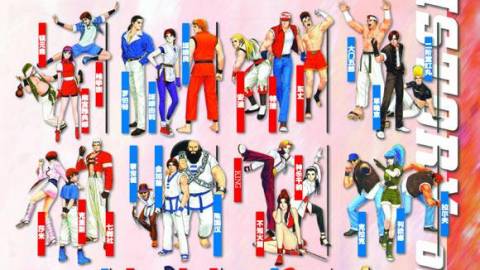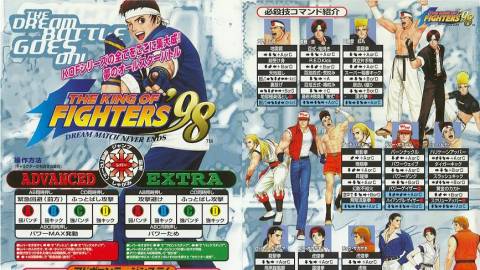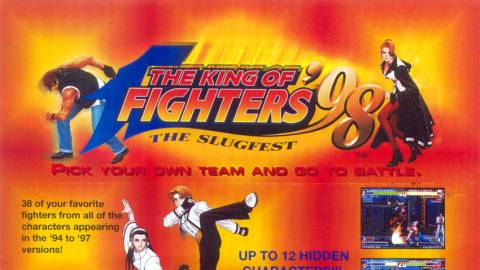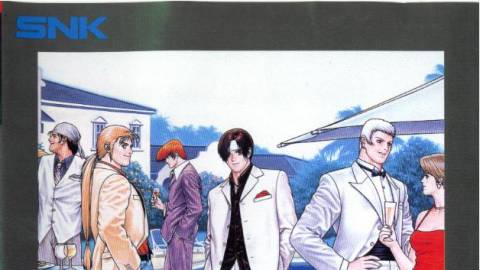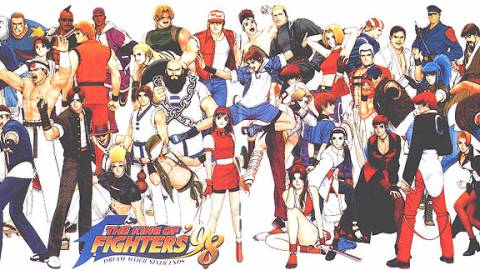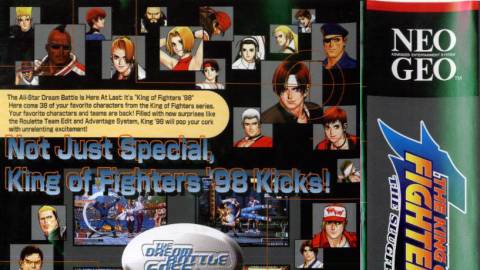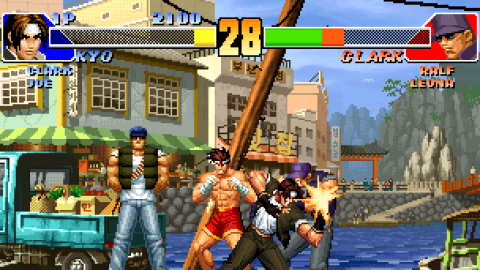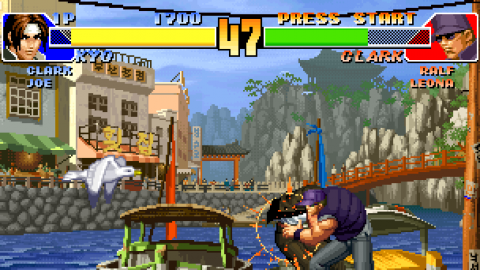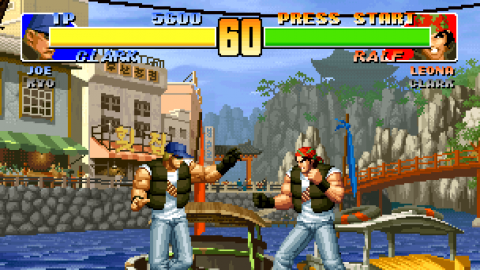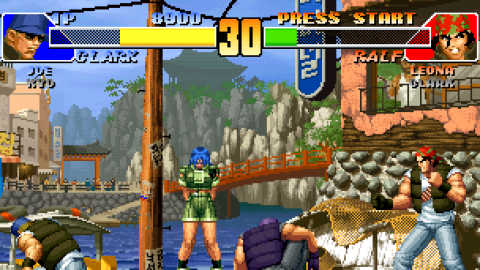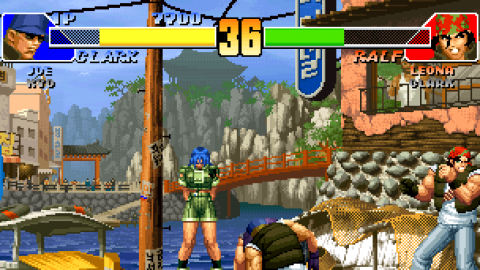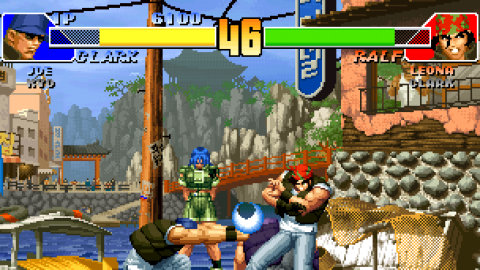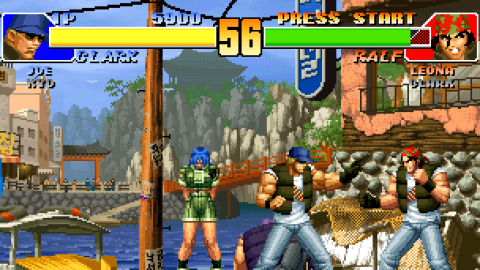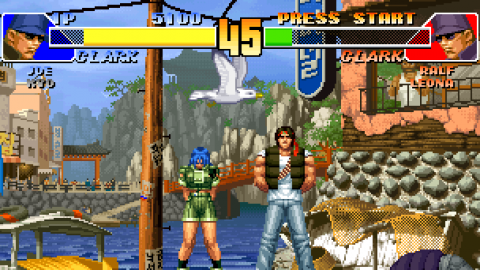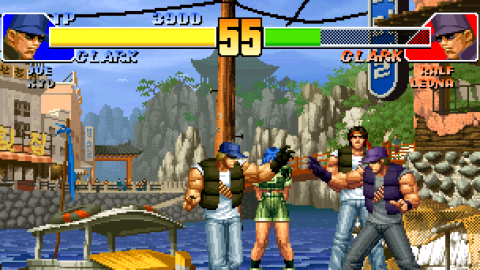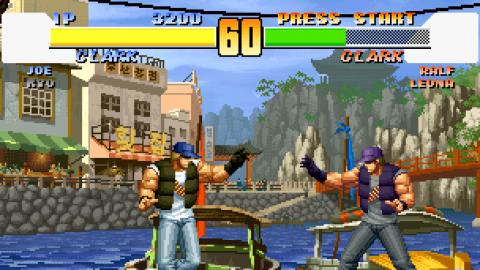Overview
The King of Fighters '98: The Slugfest (known in Japan as The King of Fighters '98: Dream Match Never Ends) is a 2D tag-team fighting game developed and released by SNK for arcades (running Neo Geo MVS hardware) on July 23, 1998. It was subsequently released for the Neo Geo AES and Neo Geo CD later that year.
The fifth installment of the King of Fighters series (and the sequel to The King of Fighters '97), King of Fighters '98 brings together most of the roster in the series for a non-canonical "Dream Match". It further updates the Command Mode system introduced in the previous game (while removing the "worldwide festival" aesthetic). Most of the characters from all games in the series are playable, with original antagonist Rugal Bernstein returning as the game's final boss.
Along with numerous ports and re-releases, the game received an enhanced remake for arcades to celebrate the game's 10th anniversary. Titled The King of Fighters '98: Ultimate Match, this version features the entire roster from the series (prior to '98), and revamped Command Modes (including a new "Ultimate" mode), and revamped UI. It received numerous revisions and console versions (the latter adding updated 3D backgrounds and arranged soundtracks, with some versions having online multiplayer).
Gameplay
The King of Fighters '98 plays like a traditional 2D fighting game, using four buttons (Light Punch, Light Kick, Strong Punch, and Strong Kick). Most of the gameplay remains the same as its predecessor, with some new additions and changes (including updated movelists for all characters).
In addition to the traditional match condition of best-of-three rounds between two fighters (which can be enabled by the arcade operator or in the home version), the game's main match condition is having teams of three competing against each-other in single-elimination rounds. The winner of each fight receives some of their vitality back and goes on to fight the next person on the opposing team, continuing until all fighters from one team are eliminated.
Main Changes from King of Fighters '97
- Both Command Modes are updated with new techniques and updated Power Gauges (the latter of which gains efficiency as more allies are defeated).
- Advanced Mode users can now fill up their Gauge while in "MAX" state.
- Extra Mode users can now cancel their sidestep dodge into a unique attack (similar to The King of Fighters '95).
- Players can now use the new "Roulette?" slot in the character select screen to randomize the choices for the remainder of their team.
- Players can no longer see Teammate Affinities in the Character Select screen.
Advanced Techniques
- Holding forward or backwards on the joystick wile pressing a Strong button at a close distance can make the fighter perform an unblockable throw. Strong Punch performs a forwards throw, while Strong Kick performs a backwards throw.
- Double-tapping the joystick backwards can make the fighter perform a hopping backwards dash, allowing players to widen the gap between both fighters.
- Pressing Down on the joystick quickly before jumping (or jumping during a forwards run) performs a more effective jump (as shown with the fighter leaving an "afterimage" trail).
- Pressing both Strong buttons simultaneously can make the fighter perform a knockdown attack that pushes away opponents (knocking them down in the process). While stronger than normal Strong attacks, it has a lengthy animation that leaves the fighter vulnerable to attacks.
- When in a dizzied state (after being damaged by numerous consecutive attacks), repeatedly tapping Light Kick and both Punch buttons simultaneously while close to the fighter's allies (and that fighter is not the last teammate standing) can make that fighter perform an assist attack, where the ally that's next-to-fight jumps in for a knockdown strike (buying the fighter time to recover). The chance to perform the attack is based on the ally's Affinity with the fighter (positive Affinity gives a higher chance, negative Affinity gives a lower chance).
- Each fighter has a hidden Teammate Affinity with all other fighters in the roster, determining their success rate in assist attacks and how much of the Advanced Power Gauge is retained when the previous fighter is defeated. While it's hidden at first glance, players can preview the Affinity between the highlighted fighter and the other fighters by holding down the Player Start button in the Order Select screen.
Command Modes
Returning from The King of Fighters '97 is the ability to choose between two distinct playstyles (or "Command Modes"), each with their own unique techniques and power gauges:
Advanced Mode
For those who prefer a newer-style Power Gauge and the more offensive avoidance attack of The King of Fighters '96.
Pressing both Light buttons simultaneously can make the fighter perform a forwards rolling dodge used for avoiding attacks (including projectiles) and cross-up opportunities (as one fighter can roll past the other, forcing them to adapt). While holding backwards on the joystick, this uses a backwards rolling dodge instead. It can also be used to escape standard throws.
In addition, dashing forward uses the running dash from The King of Fighters '95. While it's slower than normal dashes, it can be held down and released for better control.
Tapping Up on the joystick (rather than holding Up) performs a shorter hop for quicker recovery.
Power Gauge
The Advanced Power Gauge's main draw is the option to store up to three charges, or "stocks" of the gauge to use later. After filling the main gauge, it depletes and one Stock lights up. After three Stocks are lit, the gauge cannot be filled at all until a Stock is used. The gauge is charged mainly by performing special moves, but is also charged at a slower pace by both giving and receiving damage.
Each Stock can be used up to activate one of four things: a Super Special Move, a Guard Cancel Dodge, a Guard Cancel Attack, and a "MAX" state. The MAX state (as indicated by the fighter flashing bright) is similar to that of previous games, where the fighter's basic attacks become stronger (by +25%) for 20 seconds. While players can use additional Stocks for the other three attacks in MAX state (with the Super Special Move changed to a flashier, more powerful "MAX" version of it), players can not end the MAX state prematurely to perform the other techniques for free.
Unlike the Extra Power Gauge, the Advanced Power Gauge does not fully reset between each round. If the player won the previous round, their gauge remains the same. Otherwise, the gauge itself is fully depleted and their Stocks remain the same. In the game's Team Mode, players gain an additional Stock if the current character has a positive Affinity with the previous character and lose all Stocks if the current character has a negative Affinity with the previous character. Also, in Team Mode, players gain an extra Stock slot for each ally defeated (with the maximum total of 5 Stocks).
Unlike in previous games, players with the Advanced Power Gauge can not perform a Super Special Move at any time while their vitality is low.
Extra Mode
For those who prefer the classic Power Gauge and the more defensive avoidance attack of The King of Fighters '95.
Rather than a rolling dodge, pressing both Light buttons simultaneously can make the fighter perform a side-step dodge (called an "Avoid"), shifting the player's fighter to the background to avoid attacks (including projectiles). However, it leaves them vulnerable to throws. Pressing any attack button while dodging can interrupt it for a bonus attack. Rolling dodges are still used in certain situations, though (such as Guard Cancel Dodges and using the command to instantly recover from a knockdown).
In addition, dashing forward uses the hopping dash from The King of Fighters '95. While it is less controllable, it can be a faster maneuver for closing the gap.
Power Gauge
The Extra Power Gauge's main draw is the added ability to charge the gauge manually. By holding down Light Kick and both Punch buttons simultaneously, the fighter can begin charging up (while leaving themselves vulnerable to attacks). It is also charged automatically at a slower pace by blocking attacks and receiving damage. It also resets between each round.
Once the Power Gauge is filled, the player enters a "MAX" state (as indicated by the fighter flashing bright) where their basic attacks become stronger (by +50%) for 20 seconds. After that time elapses, the MAX state ends and their Power Gauge is fully depleted. However, players can end the MAX state prematurely by performing either a Super Special Move, a Guard Cancel Dodge, or a Guard Cancel Attack.
Like in previous games, players with the Extra Power Gauge can perform a Super Special Move at any time when their vitality is low (as shown by a blinking life bar). However, performing this technique while in the MAX state at low vitality changes it to a flashier, more powerful "MAX" version of it. In addition, activating MAX state with a low vitality increases the duration to 25 seconds (as shown by a larger timer bar).
In Team Mode, the Extra Power Gauge shrinks for each ally defeated, granting faster access to "MAX" state.
Characters
The game's roster is mostly unchanged from The King of Fighters '97, including 38 playable fighters split into 12 teams (with two characters as their own single entries).
While there are no new or removed playable characters, 9 characters from previous entries in the series return. These include the "American Sports Team" from The King of Fighters '94 and the "Yagami Team" from The King of Fighters '96. Three characters from The King of Fighters '95 return as the new "Masters Team" (as they are mentors and teachers of some of the other teams). Rugal Bernstein returns as the game's final boss, and is made playable from the start in his normal form.
While many characters from previous entries return, the game does not include the boss characters from the past two entries (Goenitz and Orochi), the '96 Boss team (Geese Howard, Wolfgang Krauser, and Mr. Big), and the characters Eiji Kisaragi and Kasumi Todoh. While the cursed "Orochi" versions of Iori Yagami and Leona are no longer playable, they do appear in certain Super Special Moves.
Hero Team
- Kyo Kusanagi (also has an alternate EX version based on his gameplay style in The King of Fighters '95)
- Benimaru Nikaido
- Goro Daimon
Fatal Fury Team
- Terry Bogard (also has an alternate EX version based on his gameplay style in the Real Bout Fatal Fury series)
- Andy Bogard (also has an alternate EX version based on his gameplay style in the Real Bout Fatal Fury series)
- Joe Higashi (also has an alternate EX version based on his gameplay style in the Real Bout Fatal Fury series)
Art of Fighting Team
- Ryo Sakazaki (also has an alternate EX version based on his gameplay style in The King of Fighters '95)
- Robert Garcia (also has an alternate EX version based on his gameplay style in The King of Fighters '95)
- Yuri Sakazaki (also has an alternate EX version based on her gameplay style in The King of Fighters '95)
Ikari Warriors Team
Psycho Soldier Team
Women Fighters Team
- Chizuru Kagura
- Mai Shiranui (also has an alternate EX version based on her gameplay style in the Real Bout Fatal Fury series)
- King
Kim Team
'97 Orochi Team
- Yashiro Nanakase (also has an alternate "Orochi" version)
- Shermie (also has an alternate "Orochi" version)
- Chris (also has an alternate "Orochi" version)
'97 Special Team
- Ryuji Yamazaki
- Blue Mary
- Billy Kane (also has an alternate EX version based on his gameplay style in the Real Bout Fatal Fury series)
'96 Yagami Team
- Iori Yagami
- Mature (returning from The King of Fighters '96)
- Vice (returning from The King of Fighters '96)
'95 Masters Team
- Heidern (sub-boss, returning from The King of Fighters '95)
- Takuma Sakazaki (sub-boss, returning from The King of Fighters '95)
- Saisyu Kusanagi (sub-boss, returning from The King of Fighters '95)
'94 American Sports Team
- Heavy D! (returning from The King of Fighters '94)
- Lucky Glauber (returning from The King of Fighters '94)
- Brian Battler (returning from The King of Fighters '94)
Other
- Rugal Bernstein (returning from The King of Fighters '95, with his "Omega" form as the game's unplayable final boss)
- Shingo Yabuki (also serves as the game's hidden mid-boss)


 Mac
Mac PlayStation
PlayStation Neo Geo
Neo Geo Wii Shop
Wii Shop PC
PC iPhone
iPhone iPad
iPad Android
Android Nintendo Switch
Nintendo Switch